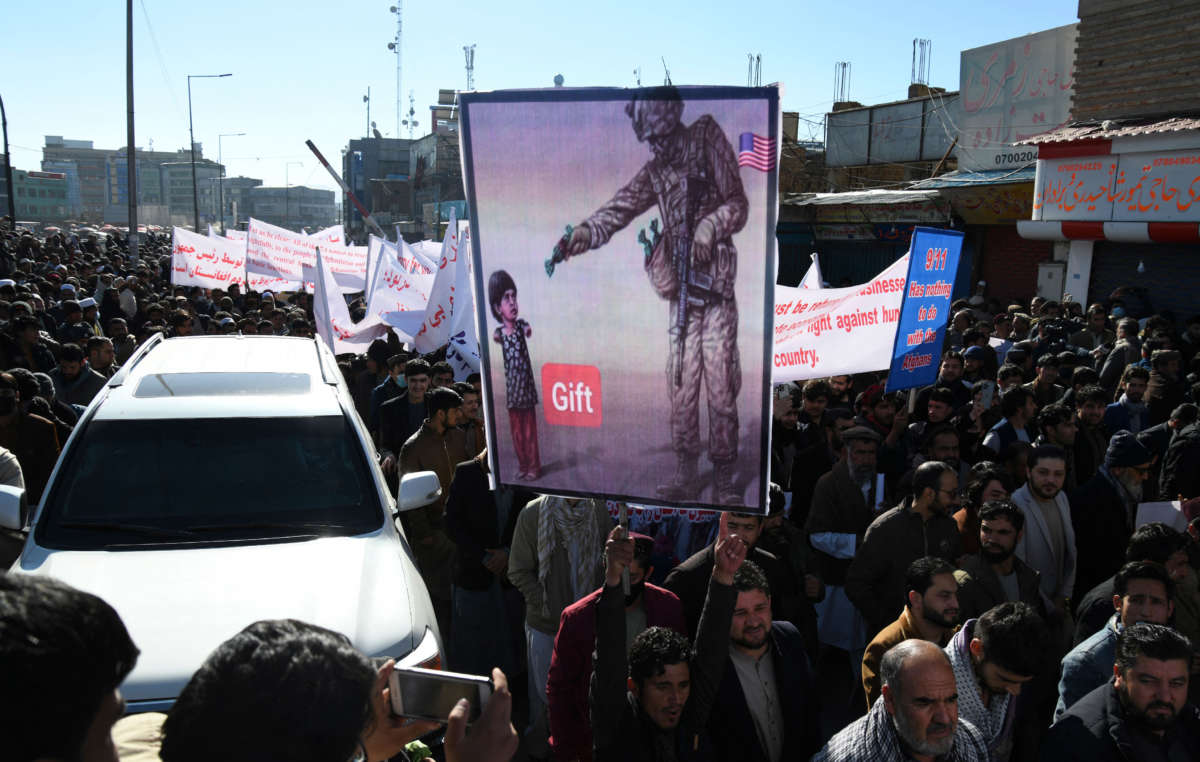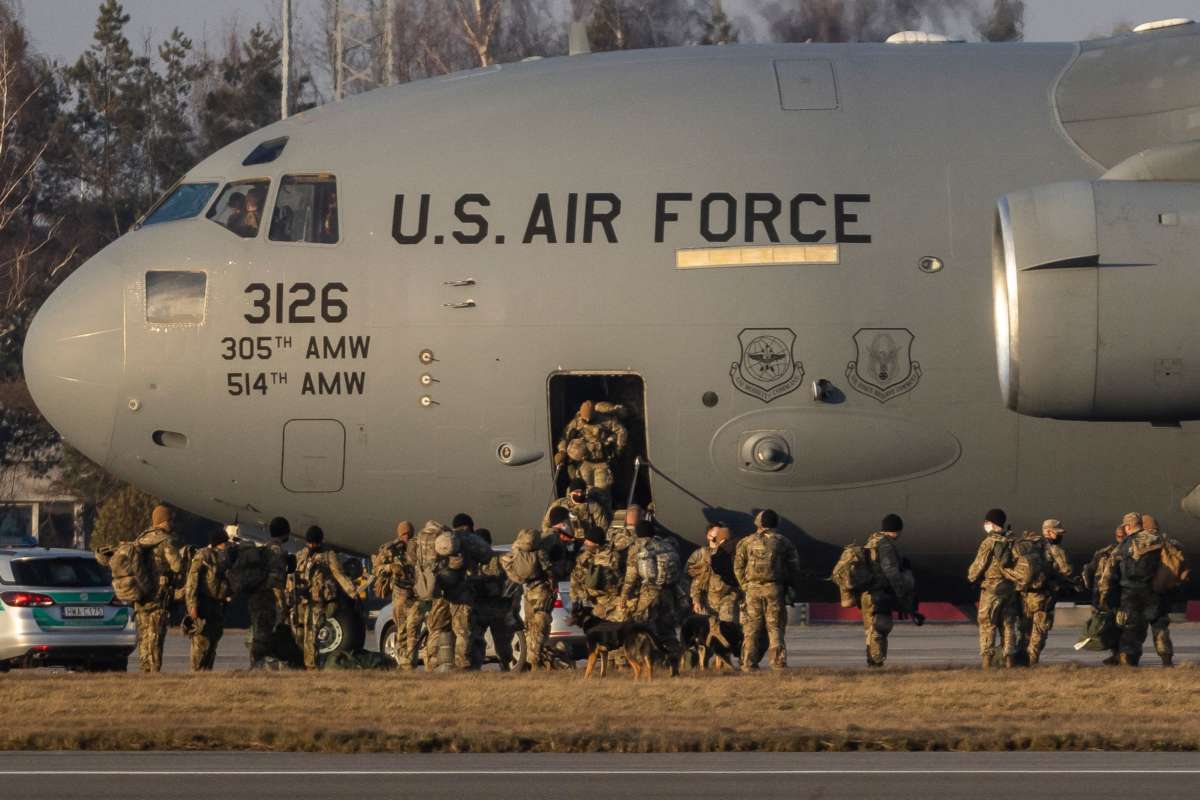As the Biden administration continues to warn of a "looming" attack, anti-war advocates urge diplomacy and dedication to playing "a cooperative and constructive role in this new multipolar world."

A member of the U.S. Army speaks with Stefan Zemanovic, the spokesperson for the Slovakian armed forces, on February 17, 2022 in Kuchyna, Slovakia. (Photo: Zuzana Gogova/Getty Images)
JESSICA CORBETT
TRUTH OUT
February 17, 2022
Amid global demands for urgent diplomacy to de-escalate the Ukraine crisis, the Russian Ministry of Foreign Affairs on Thursday rebuffed allegations by the Biden administration—along with other Western governments and corporate media—that Russia intends to imminently invade its neighbor.
"Rather than invoking a global order that no longer exists, the Biden administration should consider an agreement that offers a path out of this mess."
"There is no 'Russian invasion' of Ukraine, which the U.S. and its allies have been announcing officially since last fall, and it is not planned, therefore, statements about 'Russia's responsibility for escalation' can be regarded as an attempt to exert pressure and devalue Russia's proposals for security guarantees," said the ministry in its official response to a U.S. statement issued last month on Moscow's security demands, including Ukraine's exclusion from the North Atlantic Treaty Organization (NATO).
"We are calling on the U.S. and NATO to return to compliance with international commitments in the area of upholding peace and security," the ministry's document explains, according to the Russian news agency TASS. "We expect concrete proposals from the alliance's members about the form and substance of the legal confirmation that further eastward expansion by NATO will be abandoned."
The Russian statement, which centralizes "practical measures on de-escalation," accuses the United States of failing to provide a constructive response to Moscow's demands, adding that "this approach and the accompanying narrative by U.S. officials are reinforcing substantiated doubts that Washington is really committed to rectifying the European security situation."
"In the absence of readiness of the U.S. side to negotiate solid, legally binding guarantees of our security by the US and its allies," the document states, "Russia will have to react, including via implementation of measures of military-technical nature."
The ministry's comments came the same day U.S. President Joe Biden told reporters that although "there's a clear diplomatic path" out of the crisis, he believes Russia will invade Ukraine "in the next several days."
U.S. Secretary of State Antony Blinken on Thursday warned—though he provided no evidence—of "Russia's looming aggression against Ukraine" in remarks to the United Nations Security Council.
Along with repeating claims about a potential false flag operation by Russia as "a pretext for its attack," Blinken urged Moscow to make clear that it is not planning an invasion while also suggesting that such a statement would not be taken seriously by the U.S. administration.
As Blinken put it:
I have no doubt that the response to my remarks here today will be more dismissals from the Russian government about the United States stoking hysteria or that it has "no plans" to invade Ukraine.
Amid global demands for urgent diplomacy to de-escalate the Ukraine crisis, the Russian Ministry of Foreign Affairs on Thursday rebuffed allegations by the Biden administration—along with other Western governments and corporate media—that Russia intends to imminently invade its neighbor.
"Rather than invoking a global order that no longer exists, the Biden administration should consider an agreement that offers a path out of this mess."
"There is no 'Russian invasion' of Ukraine, which the U.S. and its allies have been announcing officially since last fall, and it is not planned, therefore, statements about 'Russia's responsibility for escalation' can be regarded as an attempt to exert pressure and devalue Russia's proposals for security guarantees," said the ministry in its official response to a U.S. statement issued last month on Moscow's security demands, including Ukraine's exclusion from the North Atlantic Treaty Organization (NATO).
"We are calling on the U.S. and NATO to return to compliance with international commitments in the area of upholding peace and security," the ministry's document explains, according to the Russian news agency TASS. "We expect concrete proposals from the alliance's members about the form and substance of the legal confirmation that further eastward expansion by NATO will be abandoned."
The Russian statement, which centralizes "practical measures on de-escalation," accuses the United States of failing to provide a constructive response to Moscow's demands, adding that "this approach and the accompanying narrative by U.S. officials are reinforcing substantiated doubts that Washington is really committed to rectifying the European security situation."
"In the absence of readiness of the U.S. side to negotiate solid, legally binding guarantees of our security by the US and its allies," the document states, "Russia will have to react, including via implementation of measures of military-technical nature."
The ministry's comments came the same day U.S. President Joe Biden told reporters that although "there's a clear diplomatic path" out of the crisis, he believes Russia will invade Ukraine "in the next several days."
U.S. Secretary of State Antony Blinken on Thursday warned—though he provided no evidence—of "Russia's looming aggression against Ukraine" in remarks to the United Nations Security Council.
Along with repeating claims about a potential false flag operation by Russia as "a pretext for its attack," Blinken urged Moscow to make clear that it is not planning an invasion while also suggesting that such a statement would not be taken seriously by the U.S. administration.
As Blinken put it:
I have no doubt that the response to my remarks here today will be more dismissals from the Russian government about the United States stoking hysteria or that it has "no plans" to invade Ukraine.
So let me make this simple. The Russian government can announce today—with no qualification, equivocation, or deflection—that Russia will not invade Ukraine. State it clearly. State it plainly to the world. And then demonstrate it by sending your troops, your tanks, your planes back to their barracks and hangars and sending your diplomats to the negotiating table.
The U.S. diplomat also cast doubt on whether Russia is drawing down troops near its border with Ukraine, telling the international body that "we do not see that happening on the ground."
Various Western officials have made similar remarks since Russian President Vladimir Putin said Tuesday that "it's a partial withdrawal of troops from the areas of our exercises."
As The New York Times reports:
The Russian Defense Ministry said on Thursday that troops had redeployed hundreds of miles away from the Ukrainian border areas after conducting military exercises.
The ministry's spokesman, Maj. Gen. Igor Konashenkov, said that logistics units of the western military district had traveled more than 400 miles from the Kursk region, bordering Ukraine, and returned to their base in the town of Dzerzhinsk in central Russia.
Several other military groups traveled more than 900 miles by railway with their equipment and were redeployed to Chechnya and Dagestan, he said. The troops currently engaged in military exercises in Belarus, to Ukraine's north, will also return to their home bases once the drills are over, Gen. Konashenkov said in a statement.
Meanwhile, anti-war advocates around the world are imploring all parties to focus on de-escalating the conflict, particularly given the U.S. and Russia's nuclear capabilities.
The Nation's editor and publisher, Katrina vanden Heuvel, argued Tuesday in her weekly column for The Washington Post that "rather than invoking a global order that no longer exists, the Biden administration should consider an agreement that offers a path out of this mess."
Vanden Heuvel, also president of the American Committee for U.S.-Russia Accord, laid to waste Blinken's defense of NATO's "open door" admission policy, pointing out that "Ukraine is in no position" to "contribute to the security of the North Atlantic area," as the alliance's founding treaty requires.
Further countering Blinken's recent statements, she wrote that "the post-Cold War international order—with the United States as a unipolar power—is already over," noting that earlier this month, "Russian and Chinese leaders declared in a joint communique that they seek a 'new era' and will no longer accede to the American-led order."
"Finally, those principles that Blinken invokes apparently were meant to apply only to others," she added. "After its disastrous offensive war of choice in Iraq, the United States is not exactly the exemplar of a rules-based order. The Monroe Doctrine, the sanctions on Iran and Venezuela, the Cuba embargo, and even NATO itself all mock Blinken's strictures against spheres of influence and dictating other countries' policies."
Writing Thursday for Common Dreams, Medea Benjamin and Nicolas J.S. Davies of the anti-war group CodePink noted that while the crisis could fizzle out or Russia could invade, the Ukrainian government could also escalate "its civil war against the self-declared People's Republics of Donetsk (DPR) and Luhansk (LPR), provoking various possible reactions from other countries."
Their warning that "a Ukrainian government attack on the DPR or LPR could be passed off in the West as a 'false flag' provocation by Russia" came as pro-Russian separatists and Ukrainian authorities on Thursday accused each other of violating a cease-fire in Ukraine's Donbas region, which has been embroiled in conflict since 2014.
Like vanden Heuvel, Benjamin and Davies also suggested that "however it ends, this crisis should be a wake-up call for Americans of all classes and political persuasions to reevaluate our country's position in the world."
Along with specifically urging a wind-down of NATO, they wrote that "we must start thinking about how a post-imperial America can play a cooperative and constructive role in this new multipolar world, working with all our neighbors to solve the very serious problems facing humanity in the 21st century."
Our work is licensed under Creative Commons (CC BY-NC-ND 3.0). Feel free to republish and share widely.












